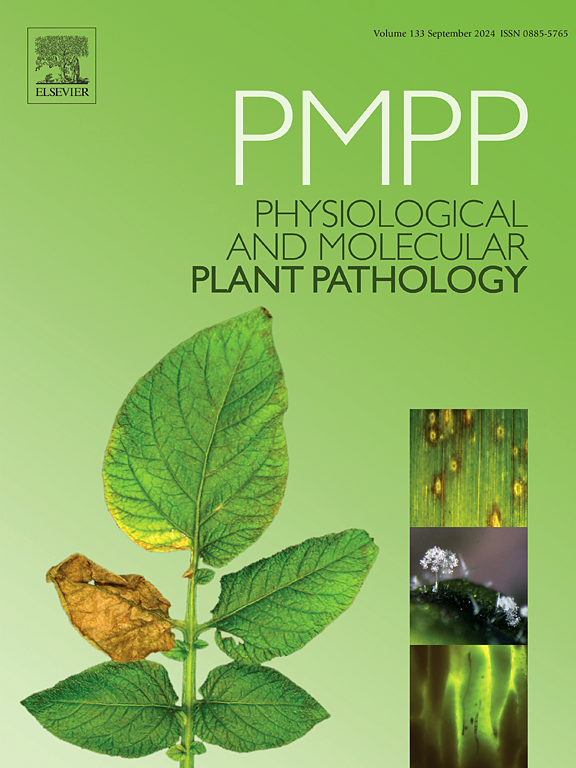Morpho-cultural variability, pathogenicity and molecular identification of Phytophthora cajani isolates causing blight disease of pigeonpea in India
IF 2.8
3区 农林科学
Q2 PLANT SCIENCES
引用次数: 0
Abstract
Phytophthora blight (PB) caused by Phytophthora cajani (Pc), is one of the most devastating diseases of pigeonpea. This study investigated the morphological, cultural, and pathogenic variability of 30 Pc isolates collected from diverse geographical regions of India. Additionally, pigeonpea genotypes were screened for resistance against Pc over five consecutive years (2017–2022) to identify stable resistant sources for future genetic improvement. Based on colony colour and texture, the Pc isolates were categorized into five groups: cottony-white fluffy (18), cottony-white mat-type (3), creamy-white fluffy (2), creamy-white mat-type (6), and light pink fluffy (1). Three isolates (Pc1, Pc24, Pc26) exhibited fast sporulation, with radial growth exceeding 80 mm. Regarding sporangial morphology, the isolates were classified into 3 groups, i.e., papillate (14 isolates), semi-papillate (11 isolates), and non-papillate (5 isolates). Among these, isolate Pc17 exhibited the largest sporangia (22.6 μm × 14.2 μm). Of the 30 isolates screened in vivo, 16 were classified as highly pathogenic, causing >50 % disease mortality, with six isolates (Pc12, Pc14, Pc16, Pc18, Pc21, and Pc24) being highly aggressive causing >90 % disease mortality. The pathogenicity of all Pc isolates was confirmed and highly pathogenic isolates were further characterized using ITS primers. Among the 30 pigeonpea genotypes tested, 13 exhibited moderate resistance over five years. Genotypes IPAC-3 and IPAPB-7-2-1-7 showed the lowest mean disease mortality (9–10 %), while IPAC-2 demonstrated the most stable performance, with a mean disease mortality of 16.2 %. Our study highlights the significant differences in morphological, cultural, and pathogenic features of Pc isolates. The stable resistant genotypes identified here provide promising avenues for developing durable resistance against PB in pigeonpea.
印度鸽豌豆枯萎病疫霉菌分离株的形态培养变异、致病性和分子鉴定
疫霉疫病(Phytophthora blight, PB)是由疫霉(Phytophthora cajani, Pc)引起的鸽豌豆疫病,是鸽豌豆最具破坏性的病害之一。本研究调查了从印度不同地理区域收集的30株Pc分离株的形态、培养和致病变异性。此外,连续5年(2017-2022年)筛选鸽子豌豆基因型对Pc的抗性,以确定稳定的抗性来源,用于未来的遗传改良。根据菌落的颜色和质地,将分离菌株分为棉白色蓬松型(18)、棉白色垫型(3)、乳白色蓬松型(2)、乳白色垫型(6)和淡粉色蓬松型(1)5个类群。其中3个分离菌株Pc1、Pc24、Pc26产孢速度较快,径向生长均超过80 mm。孢囊形态分为3类,即乳突状(14株)、半乳突状(11株)和非乳突状(5株)。其中,分离物Pc17孢子囊最大(22.6 μm × 14.2 μm)。在体内筛选的30株分离株中,16株为高致病性,导致50%的疾病死亡率,6株(Pc12、Pc14、Pc16、Pc18、Pc21和Pc24)具有高侵袭性,导致90%的疾病死亡率。所有分离株的致病性均得到证实,高致病性分离株利用ITS引物进一步鉴定。在30个基因型中,13个基因型在5年内表现出中度抗性。基因型IPAC-3和IPAPB-7-2-1-7的平均病死率最低(9 - 10%),而基因型IPAC-2表现最稳定,平均病死率为16.2%。我们的研究强调了Pc分离株在形态、文化和致病特征上的显著差异。本文所鉴定的稳定抗性基因型为建立鸽豆对PB的持久抗性提供了良好的途径。
本文章由计算机程序翻译,如有差异,请以英文原文为准。
求助全文
约1分钟内获得全文
求助全文
来源期刊
CiteScore
4.30
自引率
7.40%
发文量
130
审稿时长
38 days
期刊介绍:
Physiological and Molecular Plant Pathology provides an International forum for original research papers, reviews, and commentaries on all aspects of the molecular biology, biochemistry, physiology, histology and cytology, genetics and evolution of plant-microbe interactions.
Papers on all kinds of infective pathogen, including viruses, prokaryotes, fungi, and nematodes, as well as mutualistic organisms such as Rhizobium and mycorrhyzal fungi, are acceptable as long as they have a bearing on the interaction between pathogen and plant.

 求助内容:
求助内容: 应助结果提醒方式:
应助结果提醒方式:


